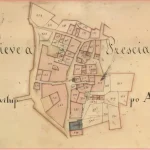You are standing in front of one of the towers of the Castle, the northern one. This location, which bears characteristics typical of a medieval village, has deep roots in antiquity. Its name actually comes from the Latin “praedium Prisci,” indicating the ancient presence of settlements near the Presciano stream. Situated at a crossroads of roads linking the Valdichiana to the Valdarno and the territory of Arezzo to Siena, Pieve a Presciano became an important passageway for people and goods, as well as a well-known agricultural center.
The village takes its name from its Pieve, located at the foot of the Castle on the southern side, with origins dating back to the early Christian period. This religious building, better known as the Pieve di San Pietro Apostolo, played an important role in the history of this village. During the early Middle Ages, when the nearby Abbey of Agnano gained power and influence, the Pieve came under the abbey’s control. A document from 1095 attests to this fact. The jurisdiction of the Pieve was extensive, stretching from Levane to Civitella. In the 11th century, the Pieve underwent a renovation in the Romanesque style. It is likely that the church had a single nave with a wooden truss roof. The first document mentioning the Pieve dates back to 1021, found in a deed signed at the Castle of Bulgari. According to the 13th-century Relazioni Decimali (tax records), the Pieve had 10 subsidiary churches.
Much of the current appearance of the Pieve is due to the efforts of the parish priest Giovan Battista Salimbeni, who, among other improvements, purchased a new high altar in 1862 from the canons of the Florentine Basilica of San Lorenzo.
Returning to our village, you should know that in the 14th century, its territory was significantly influenced by the expansion of Florence. This period marked a time of change and conflict for the community of Pieve a Presciano. In 1350, the village became part of Florence’s holdings. During those turbulent years, defensive walls were built, and the village became fortified. The walls, which began construction in 1355, were built in the typical fuso style of the time. Several towers are still visible today, though many have been converted into modern homes, including Villa Ghezzi. Another tower was incorporated into the Palagio Serristori, which you will encounter later. However, the Pieve remained outside the walls of the Castle.
In the 15th century, during the wars between Florence and Siena, the Valdambra region suffered numerous attacks from both sides, and Pieve a Presciano was repeatedly assaulted and looted. In July 1554, after an heroic defense by the last 33 inhabitants, the Castle of Pieve was looted and burned by the troops of the mercenary captain Pietro Strozzi, a Florence exile allied with the Sienese and the King of France. After the Florentine victory, the castle was rebuilt by the Serristori family, but it lost its military function, and within its walls, a villa began to develop.
With the advent of the “Pax Medicea” under the Grand Duchy of Tuscany and the policy of promoting the acquisition of large estates by Florentine families connected to the Medici power, the fortunes of the Ghezzi, Alberti, and Serristori families—who would become the dominant family in the area—grew in this region.
The road network on the eastern side, along with the area of the gardens that once served as a public square for the livestock market, is the result of the work of Count Umberto Serristori, who at the time was a Senator of the Kingdom. In 1907, in agreement with the Municipality of Pergine Valdarno, Count Serristori carried out these significant works in exchange for the closure of the public road that crossed the Serristori estate, located on the countryside side. Later on, you will have the opportunity to admire this palace from the village side.




